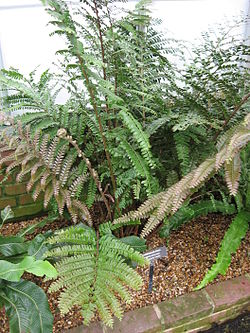Hypodematiaceae , la enciclopedia libre
| Hypodematiáceas | ||
|---|---|---|
 Didymochlaena truncatula | ||
 Órganos y ciclo de vida de un helecho típico. | ||
| Taxonomía | ||
| Reino: | Plantae | |
| División: | Monilophyta | |
| Clase: | Polypodiopsida | |
| Subclase: | Polypodiidae | |
| Orden: | Polypodiales | |
| Familia: | Hypodematiaceae (familia nº 41) | |
| genera | ||
Según Christenhusz et al. 2011[1][2][3] (basada en Smith et al. 2006,[4] 2008);[5] que también provee una secuencia lineal de las licofitas y monilofitas. | ||
- Ver Pteridophyta para una introducción a las plantas vasculares sin semilla
Las hypodematiáceas (nombre científico Hypodematiaceae) son una familia de helechos del orden Polypodiales, en la moderna clasificación de Christenhusz et al. 2011.[1][2][3] La familia no fue reconocida por su predecesor sistema de Smith et al. (2006),[4] de hecho estos géneros anteriormente nunca fueron asociados.
Taxonomía
[editar]- Introducción teórica en Taxonomía
La clasificación más actualizada es la de Christenhusz et al. 2011[1][2][3] (basada en Smith et al. 2006,[4] 2008);[5] que también provee una secuencia lineal de las licofitas y monilofitas.
- Familia 41. Hypodematiaceae Ching, Acta Phytotax. Sin. 13: 96 (1975).
- 3 géneros (Didymochlaena, Hypodematium, Leucostegia).[6][7][8][n 1]
Filogenia
[editar]- Introducción teórica en Filogenia
Estos géneros tradicionalmente no fueron asociados. Hypodematium fue asociado con los helechos athirioides, Didymochlaena fue antes ubicado en Dryopteridaceae y Leucostegia en Davalliaceae. Muchos estudios (Liu et al. 2007a, Tsutsumi & Kato 2006, Schuettpelz & Pryer 2007) han encontrado que están relacionados y probablemente son el clado hermano de 'Eupolypods I'.
Caracteres
[editar]Con las características de Pteridophyta.
Véase también
[editar]- Clasificación de los organismos vegetales.
- Para una descripción básica de morfología y anatomía de los helechos ver Pteridophyta.
Notas
[editar]- ↑ Estos géneros tradicionalmente no fueron asociados. Hypodematium fue asociado con los helechos athirioides, Didymochlaena fue antes ubicado en Dryopteridaceae y Leucostegia en Davalliaceae. Varios estudios han encontrado que están relacionados y probablemente son el clado hermano de 'Eupolypods I'.[6][7][8]
Referencias
[editar]- ↑ a b c Christenhusz et al. 2011. A linear sequence of extant families and genera of lycophytes and ferns. Phytotaxa 19: 7-54. (pdf)
- ↑ a b c Preface to “Linear sequence, classification, synonymy, and bibliography of vascular plants: Lycophytes, ferns, gymnosperms and angiosperms” pdf
- ↑ a b c Corrections to Phytotaxa 19: Linear sequence of lycophytes and ferns pdf
- ↑ a b c A. R. Smith, K. M. Pryer, E. Schuettpelz, P. Korall, H. Schneider, P. G. Wolf. 2006. "A classification for extant ferns". Taxon 55(3), 705-731 ( pdf)
- ↑ a b Smith, A.R., Pryer, K.M., Schuettpelz, E., Korall, P., Schneider, H., & Wolf, P.G. (2008) Fern classification, pp. 417–467 en: Ranker, T.A., & Haufler, C.H. (eds.), Biology and Evolution of Ferns and Lycophytes. Cambridge , Cambridge University Press.
- ↑ a b Liu et al., 2007a
- ↑ a b Tsutsumi y Kato, 2006
- ↑ a b Schuettpelz y Pryer, 2007
Bibliografía
[editar]- Pryer, Kathleen M., Harald Schneider, Alan R. Smith, Raymond Cranfill, Paul G. Wolf, Jeffrey S. Hunt y Sedonia D. Sipes. 2001. "Horsetails and ferns are a monophyletic group and the closest living relatives to seed plants". Nature 409: 618-622 (resumen en inglés aquí).
- Pryer, Kathleen M., Eric Schuettpelz, Paul G. Wolf, Harald Schneider, Alan R. Smith y Raymond Cranfill. 2004. "Phylogeny and evolution of ferns (monilophytes) with a focus on the early leptosporangiate divergences". American Journal of Botany 91:1582-1598 (resumen en inglés aquí Archivado el 26 de agosto de 2010 en Wayback Machine.).
- A. R. Smith, K. M. Pryer, E. Schuettpelz, P. Korall, H. Schneider, P. G. Wolf. 2006. "A classification for extant ferns". Taxon 55(3), 705-731 (pdf aquí)
Enlaces externos
[editar]- P. F. Stevens, 2001 en adelante, Angiosperm Phylogeny Website. Versión 9, junio de 2008, y actualizado desde entonces. http://www.mobot.org/MOBOT/research/APweb/
- Pryer's lab con los pdfs de las publicaciones de la autora.
Otros proyectos wikimedia
[editar] Wikimedia Commons alberga una categoría multimedia sobre Hypodematiaceae.
Wikimedia Commons alberga una categoría multimedia sobre Hypodematiaceae. Wikispecies tiene un artículo sobre Hypodematiaceae.
Wikispecies tiene un artículo sobre Hypodematiaceae.


 French
French Deutsch
Deutsch